![]()
![]()
![]()
Use LEFT and RIGHT arrow keys to navigate between flashcards;
Use UP and DOWN arrow keys to flip the card;
H to show hint;
A reads text to speech;
10 Cards in this Set
- Front
- Back
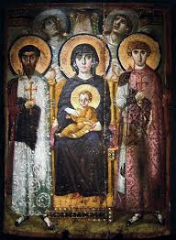
#54 Virgin (Theotokos) and Child between Saints Theodore and George - Early Byzantine Europe - 6th or early 7th century CE
Content: -Virgin Mary and child -gold halo -Saints on either side -angels at the corners -in apse of Hagia Sophia -Christ is small, but looks like an old man
Style: -gold halo is specific to Byzantine era -halo represents god-like figures, holiness, or sainthood -stylized face also specific to Byzantine art -football shaped eyes and long noses -feet dangle from clothing almost like the figures are hovering, common in medieval art -figures not at natural angles that make sense -hand positions are representative -mosaic in apse of Hagia Sophia |
Context: At this point in time in art, artists weren't completely aware of how to make the subjects realistic or perfect in a way that the ancient Greeks and Romans achieved. The faces were highly stylized in typical Byzantine style with long noses and large, football shaped eyes. This piece, like many others during the time, were full of icons. Some opposed the worship of images and icons and the representation of living things in holy places. There were Iconophiles, who worshiped those icons like the representation of the virgin Mary and Christ. And there were Iconoclasts, who believed that one shouldn't worship a representation of the living things. This conflict resulted in icons being plastered, covered, and destroyed. |
|
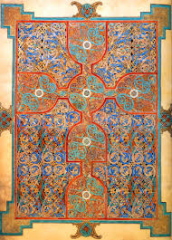
#55 Lindisfarne Gospels -Early medieval Europe/ Hiberno Saxon -c. 700 CE
Content: -illuminated manuscript -highly decorated borders -from the north -cover page -
|
Context: The Lindisfarne Gospels are illuminated manuscripts made with colored inks and gold leaf on vellum. Made in the north, they had a zoomorphic style with reoccurring images associated with animals. They also had highly decorated borders influenced by Islamic rugs. At this time illuminated manuscripts were very popular and because of the majority of the populations inability to read, they consisted largely of intricate illustrations.
|
|

#56 Great Mosque/ Great Mosque Plan -Cordoba, Spain/ Umayyad -c.785-786
Content: - mosque built around a Christian church - giant mosque - elements borrowed from roman architecture and hypostyle hall - open space - columns - red and white striped roman arch - minaret (tower representing wealth - buttresses - flying buttress - quibla wall facing towards Mecca - development of key-hole arch (defining element of Islamic take on roman architecture) - no figural representation
|
Context: The Great Mosque of Cordoba shows the growth of the Islamic faith. The mosque was built around a Christian church, the Islamic faith overcoming that of the roman catholic church in Spain. The combination of faiths resulted in a melding of their defining architecture. The mosque uses roman arches, columns, an open space, and flying buttresses for support. But it also incorporates things from Islamic culture like the modification of the roman arch into a key-hole arch, and the use of mathmatical and geometric designs instead of the incorporation of figural representation. The Islamic faith prevents the worship of icons, so there is little to no depiction of living things in their art. Instead they incorporate complex geometric designs and extremely decorative writing. |
|

#57 Pyxis of al-Mughira - Umayyad Dynasty - c. 968 CE
Content: - gift - belonged to al-Mughira - calligraphic Islamic writing - motifs and smbols o royal power - carved ivory
|
Context: This piece is hand carved ivory that was given as a gift to al-Mughira, a royal person during the Umayyad Dynasty. It is intricately carved with symbols like peacocks to represent royal power and authority. The writing around the rim of the Pyxis is calligraphic and is more of a decoration than a functional piece. This is similar to most Islamic art because of the lack of images of living things. |
|
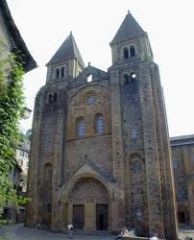
#58 Church of Sainte-Foy - Conques, France/ Romanesque Europe - Church: c. 1050-1130 CE
Content: - westwork (front façade) - two towers - little ornamentation or decoration - very large - massive construction - side isles and barrel vaults - buildings started to be built higher - dome over trancept - radiating chapels surround apse |
Context: The Romanesque era was typically this style of architecture. There is very little decoration because the church was meant to be functional. The church, like many others during this time, was built massive in order to accommodate the massive amounts of pilgrims traveling to see the relics they held. The pilgrims would travel from extremely far away to see items associated with or part of a saint or holy person. |
|
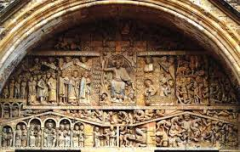
#58 The Last Judgement (tympanum) - Conques, France/ Romanesque Europe - ninth century CE
Content: - decorated half circle above the door - high relief sculpture - depiction of last judgement |
Context: The Last judgment Tympanum is one of the only decorative features of the Church of Sainte-Foy on the façade. It is a relief sculpture depicting the Last Judgment. The sculpture is representative of hell on one side and heaven on the other. In hell there are grotesque figures typical of Romanesque art. The sculpture was made as a message to all pilgrims coming in to the church that how you live in life will affect your afterlife. The sculpture of god looks down on the visitors as they enter, warning against the side of grotesque figures and hell. The pilgrims were meant to be awe-struck as they entered the massive church. |
|
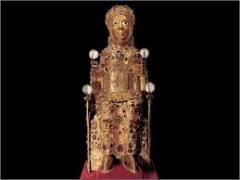
#58 Reliquary of Saint Foy - Conques, France/ Romanesque Europe - ninth century CE
Content: - sculpted container that held the relic - wooden core - gold and silver gilded on top - semi precious stones |
Context: The reliquary of Saint Foy is the main reason why pilgrims would stop at the Church of Saint Foy. Pilgrims traveled such great distances to churches in order to see and be blessed by the relics of saints or holy people. The more valuable the relic, the more popular the church would be for pilgrims. The Church of Saint Foy used a reliquary to hold the relic inside. It was valued by the church because it was their main attraction for the traveling pilgrims. |
|

#59 Bayeux Tapestry - Romanesque Europe/ (English or Norman) - c. 1066-1080
Content: - Anglo-Saxon (English) - battle of Hastings - over 70ft long - woven linen with stitched details
|
Context: The Bayeux Tapestry was created as documentation of the battle of Normandy. The battle united England and France under one rule, making the dukes of Normandy (France) kings of England. The tapestry depicts all the events leading up to, during, and after the battle in a linen creation more than 70ft long. |
|
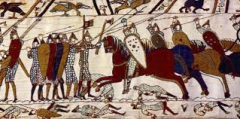
#59 Bayeux Tapestry: Cavalry Attack - Romanesque Europe/ (English or Norman) - c. 1066-1080
Content: - center register - two borders - 8 colors of dyed yarn |
Context: This part of the tapestry depicts part of the battle. 8 colors of dyed yarn are used to show the battle where men on horses (the cavalry) attack men on foot with brightly colored shields. The artist left the linen background to function as the skin of the figures instead of using colored yarn for their skin. The small amount of overlapping of the figures is similar to some mosaics during the roman empire. |
|
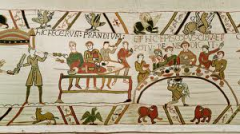
#59 Bayeux Tapestry: The First Meal - Romanesque Europe/ (English or Norman) - c. 1066-1080
Content: - end of the tapestry - figures eating a meal together |
Context: The First Meal section of the Bayeux Tapestry depicts the meal after the end of the battle of Hastings, showing the Anglo-Saxons and Normans eating together around a table. This section serves as the conclusion of the narrative, ending on a note of unity and power. Within the images are icons associated with royal families and power and the visual imagery is supported by text created by yarn. The conclusion symbolizes the formation of one of the strongest kingdoms in Western Europe during the Romanesque period. |

